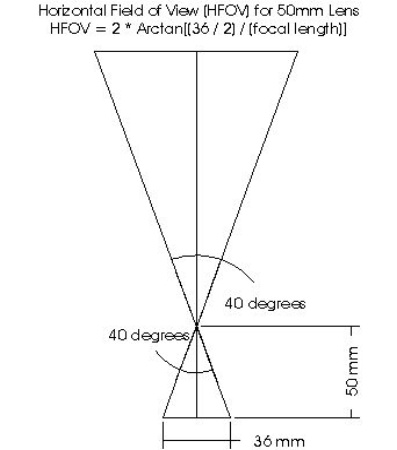
BetterPhoto Member |
|
lens angles on the ground
Hi, I would like to know how the focal length of the lens translates into the angle of view seen in the photo. I am taking repeat photos of various landscapes and to analyse the changes seen in the photo pairs I need to know more precisely how the lens I use relates to amount of view seen in the photograph. To clearify what I need: imagine a topographic map with a red dot on it representing the location of the camera when the photo was taken, then imagine two lines drawn outward from the dot in the direction the shot was taken forming a V shape representing the field of view of the photo. I want to know what the angle degree is of the V depending on the lens that I use. This will help me analyse how much map area is covered by the photograph. I hope you can answer my question. Thank you, Monica Bueno
March 26, 2001
|
|
|
John A. Lind |
|
|
|
|
|

Horizontal Field of View Calculations
Equation for finding horizontal field of view for 35mm film format with example diagram for 50mm focal length lens.
John A. Lind
|
|
|
|
Monica,
Dust off your trigonometry from school . . .First:
The Field of View (FOV) given in nearly all lens specifications is for the _diagonal_ across the film frame, not the horizontal or vertical. For what you want, you cannot use this. The FOV is directly related to the focal length and the size of the film frame. Assuming your are using 35mm "small format" the film frame is 36mm wide by 24mm tall. Imagine a triangle, the base of which is the width of the film frame and the height of which is the focal length. The Horizontal Field of View (HFOV) is the angle at the apex. The math for this is:
HFOV = 2*Arctan[(36/2)/(focal length)] This equation makes use of the fact that the tangent of an angle is its ratio of vertical rise to its horizontal run, which covers half the field of view. For a 50mm standard lens the HFOV is about 40 degrees. I've uploaded a diagram showing how this works. It's to scale for a 50mm standard lens, but the math works for any focal length. If you turn the camera vertical, substitute "24/2" (or 12) for the "36/2" (or 18) in the equation. Because the vertical height of the film frame is smaller, the VFOV is smaller than the HFOV. Note:
Focal lengths of lenses are only approximate. If you are doing these computations for "photometric" purposes and require precise measurements, you will need to determine exactly what the focal length of each lens is. To do this, shoot straight at a test chart with a horizontal ruler drawn on it from an accurately measured distance. Then examine the negative (not the print) to find exactly how wide the field is at the known distance. From this you can work out the field of view (and exact focal length) using geometry and trigonometry. -- John
March 26, 2001
|
|
|
|
Log in to respond or ask your own question.
|